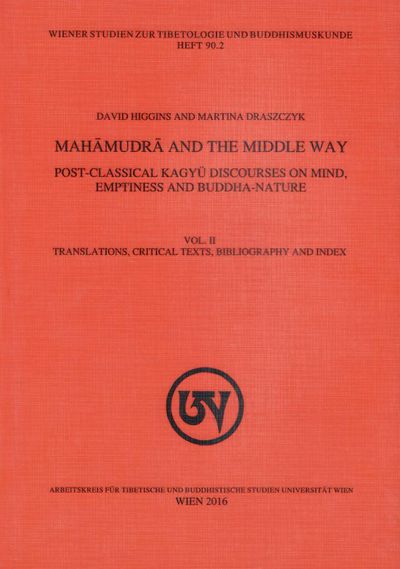Mahāmudrā and the Middle Way
< Books
((by SublimeText.Mediawiker)) |
|||
| Line 27: | Line 27: | ||
Still, the four attempts at reconciliation between doctrinal poles are a needed corrective to the many studies in which the extremes are presented as contradictory; for all four authors, the philosophical binaries were complementary and integral to the practice of Buddhism. They each advocated for an intellectual inquiry of emptiness using the language of negation favored by Geluk and mainline Sakya teachers, paired with or followed by a meditative engagement with positive-language doctrines of buddha-nature and the natural luminosity of mind. The great debates of the era between Madhyamaka and Yogacāra, zhentong and rangtong, analytical or meditative approach, Sudden vs. Gradual Enlightenment, and so forth, were for these authors not issues of either/or but matters of synthesis and balance. | Still, the four attempts at reconciliation between doctrinal poles are a needed corrective to the many studies in which the extremes are presented as contradictory; for all four authors, the philosophical binaries were complementary and integral to the practice of Buddhism. They each advocated for an intellectual inquiry of emptiness using the language of negation favored by Geluk and mainline Sakya teachers, paired with or followed by a meditative engagement with positive-language doctrines of buddha-nature and the natural luminosity of mind. The great debates of the era between Madhyamaka and Yogacāra, zhentong and rangtong, analytical or meditative approach, Sudden vs. Gradual Enlightenment, and so forth, were for these authors not issues of either/or but matters of synthesis and balance. | ||
|BookToc=VOLUME ONE | |BookToc=VOLUME ONE | ||
| − | *Acknowledgement 12 | + | * {{i|Acknowledgement|12}} |
| − | *Introduction 14 | + | * {{i|Introduction|14}} |
| − | **Current State of Research 17 | + | ** {{i|Current State of Research|17}} |
| − | **Politico-Historical Background 22 | + | ** {{i|Politico-Historical Background|22}} |
| − | **Doctrinal Background 25 | + | ** {{i|Doctrinal Background|25}} |
| − | **Navigating the Middle Ways 29 | + | ** {{i|Navigating the Middle Ways|29}} |
| − | **The Nature of Liberating Knowledge 41 | + | ** {{i|The Nature of Liberating Knowledge|41}} |
*Shākya mchog ldan 44 | *Shākya mchog ldan 44 | ||
**Shākya mchog ldan and the Bka’ brgyud Mahāmudrā Tradition 45 | **Shākya mchog ldan and the Bka’ brgyud Mahāmudrā Tradition 45 | ||
Revision as of 10:07, 9 August 2018
This two-volume publication explores the complex philosophy of Mahāmudrā that developed in Tibetan Dwags po Bka’ brgyud traditions between the 15th and 16th centuries CE. It examines the attempts to articulate and defend Bka’ brgyud views and practices by four leading post-classical thinkers: (1) Shākya mchog ldan (1423‒1507), a celebrated yet controversial Sa skya scholar who developed a strong affiliation with the Karma Bka’ brgyud Mahāmudrā tradition in the last half of his life, (2) Karma phrin las Phyogs las rnam rgyal (1456‒1539), a renowned Karma Bka’ brgyud scholar-yogin and tutor to the Eighth Karma pa, (3) the Eighth Karma pa himself, Mi bskyod rdo rje (1507‒1554), who was among the most erudite and influential scholar-hierarchs of his generation, (4) and Padma dkar po (1527‒1592), Fourth ’Brug chen of the ’Brug pa Bka’ brgyud lineage who is generally acknowledged as its greatest scholar and systematizer. It is an important academic work published in the Vienna series WSTB and is divided into two volumes: the first offers a detailed philosophical analysis of the authors’ principal views and justifications of Mahāmudrā against the background of Indian and Tibetan Buddhist doctrines on mind, emptiness and buddha nature; the second comprises an annotated anthology of their seminal writings on Mahāmudrā accompanied by critical editions and introductions. These two volumes are the result of research that was generously funded by the Austrian Science Fund (FWF) from 2012 to 2015 under the supervision of Prof. Klaus-Dieter Mathes. The project was entitled “‘Emptiness of Other’ (Gzhan stong) in the Tibetan ‘Great Seal’ (Mahāmudrā) Traditions of the 15th and 16th Centuries” (FWF Project number P23826-G15). (Source: WSTB Description)
| Citation | Higgins, David, and Martina Draszczyk. Mahāmudrā and the Middle Way: Post-Classical Kagyü Discourses on Mind, Emptiness and Buddha-Nature. Vol. II, Translations, Critical Texts, Bibliography and Index. Wiener Studien zur Tibetologie und Buddhismuskunde 90.2. Vienna: Arbeitskreis für Tibetische und Buddhistische Studien Universität Wien, 2016. |
|---|---|


